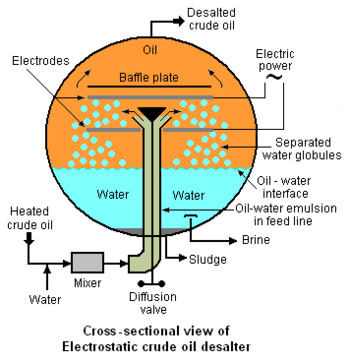User:Milton Beychok/Sandbox
A crude oil desalter is a device used in petroleum refineries to remove inorganic salts, water and sediment from the incoming petroleum crude oil feedstock before it is refined. This article focuses on the use of electrostatic desalters to produce a dehydrated, desalted crude oil with a very low sediment content.[1][2][3][4] Almost all refineries now use electrostatic desalters. However, there may still be a few refineries employing the older, less efficient method that utilizes chemicals and settling tanks.
Removal of the salts, water and sediment is necessary to avoid excessive fouling of equipment as well as corrosion from the generation of hydrochloric acid (HCl) by the hydrolysis of the chloride salts present in the incoming crude oil, in particular magnesium chloride (MgCl2) and calcium chloride (CaCl2). Any salts that are not removed represent a source of metals that can "poison"[5] expensive catalysts used in various petroleum refinery processes.[1][2][3].
The salt, water and sediment in crude oil as received by refineries
The amount of water, salts and sediment in the crude oil as received at petroleum refineries varies widely with the source of the crude oil, the prior processing of the crude oil at the source sites and with the mode of transporting the crude oil from its source to the refineries.
Typically, the raw crude oil produced by oil wells drilled into underground petroleum oil reservoirs is accompanied by brine (i.e., water containing inorganic chloride salts). The amount of chloride salts in the brine may be as high as 20 % by weight. Some of that brine is emulsified with the crude oil. The salts present in raw crude oil may be in the form of crystals dispersed in the oil and some of the salts are dissolved in the brine in their ionized form.
The salts present in petroleum crude oils are mainly chlorides with following approximate breakdown:
- 75 weight percent Sodium chloride (NaCl)
- 15 weight percent Magnesium chloride (MgCl2)
- 10 weight percent Calcium chloride (CaCl2)
The raw crude is usually subjected to processing at or very near to the oil field production sites in order to separate the oil from the brine before the oil is transported to petroleum refineries via pipeline, railway cars, tanker trucks or sea-going tanker ships. Such oilfield processing typically involves washing the oil with water to remove salts, use of demulsifying chemicals and simple settling vessels and tanks. In some cases, the oilfield processing includes electrostatic desalters as well. In general, the oilfield processing facilities strive to remove enough water, sediment and salts so that the transported crude oil contains less that 1 to 2 % by volume of sediment and water (BS&W) and less than 10 to 20 pounds of salts per 1000 barrels (PTB) of crude oil (which is equivalent to a salt content of 34 to 68 ppm by weight).[6] Nevertheless, the crude oils as received at petroleum refineries have a salt content that ranges from a PTB of 10 to 345 (34 to 1,175 ppm by weight), based on spot samples of many different crude oils as delivered to refineries.[1][7]
References
- ↑ 1.0 1.1 1.2 Jean-Pierre Wauquier (Editor) (2000). Petroleum Refining, Volume 2, Separation Processes. Editions Technip. ISBN 2-7108-0761-0. Limited preview in Google Books
- ↑ 2.0 2.1 Francis S. Manning and Richard E. Thompson (1995). Oilfield Processing, Volume 2: Crude oil. Pennwell Books. ISBN 0-87814-354-8. Limited preview in Google Books
- ↑ 3.0 3.1 Beychok, Milton R. (1967). Aqueous Wastes from Petroleum and Petrochemical Plants. John Wiley & Sons. Library of Congress Control Number 67019834.
- ↑ Petroleum Wastewater – A Case Study Greg Johnson (from Water and Wastewater.com)
- ↑ Irreversible deactivation of catalysts.
- ↑ Note: In the United States, the amount of inorganic salts in a crude oil is expressed as pounds per thousand barrels and abbreviated as PTB. Based on a crude oil having an API gravity of 34 °API (which is equivalent to having a specific gravity of 0.8550), 1 PTB of salt = 3.4 ppm by weight of salt.
Also, the amount of sediment and water present in a crude oil is expressed as % by volume of BS&W (Basic Sediment and Water) as measured by American Society for Testing and Materials (ASTM) Standards D96, D4006, D4007 or Institute of Petroleum (IP) Test Method 386. - ↑ H.K. Abdel-Aal, Mohamed Aggaour and M.A. Fahim (2003). Petroleum and Gas Field Processing. CRC Press. ISBN 0-8247-0962-4. Limited preview in Google Books

